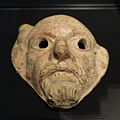You can help expand this article with text translated from the corresponding article in German. (July 2015)Click [show] for important translation instructions.
|

The Suebian knot (German : Suebenknoten) is a historical male hairstyle ascribed to the tribe of the Germanic Suebi. The knot is attested by Tacitus in his 1st century AD work Germania, found on contemporary depictions of Germanic peoples, their art, and bog bodies.











